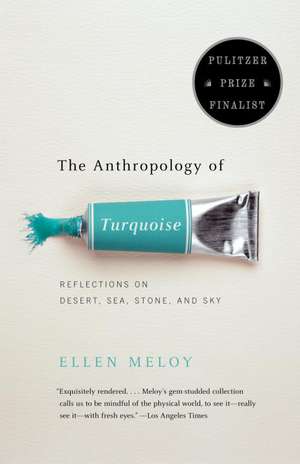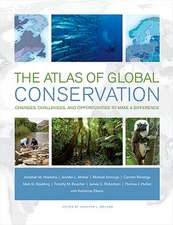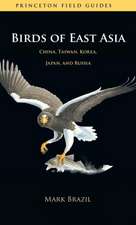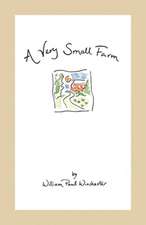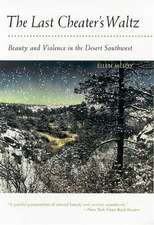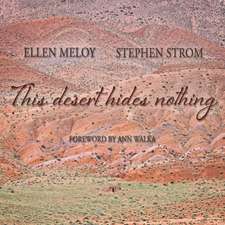The Anthropology of Turquoise: Reflections on Desert, Sea, Stone, and Sky
Autor Ellen Meloyen Limba Engleză Paperback – 30 iun 2003
Vezi toate premiile Carte premiată
Utah Book Award (2002)
From the Sierra Nevada, the Mojave Desert, the Yucatan Peninsula, and the Bahamas to her home ground on the high plateaus and deep canyons of the Southwest, we journey with Meloy through vistas of both great beauty and great desecration. Her keen vision makes us look anew at ancestral mountains, turquoise seas, and even motel swimming pools. She introduces us to Navajo “velvet grandmothers” whose attire and aesthetics absorb the vivid palette of their homeland, as well as to Persians who consider turquoise the life-saving equivalent of a bullet-proof vest. Throughout, Meloy invites us to appreciate along with her the endless surprises in all of life and celebrates the seduction to be found in our visual surroundings.
Preț: 100.63 lei
Nou
Puncte Express: 151
Preț estimativ în valută:
19.26€ • 20.03$ • 15.90£
19.26€ • 20.03$ • 15.90£
Carte disponibilă
Livrare economică 24 martie-07 aprilie
Preluare comenzi: 021 569.72.76
Specificații
ISBN-13: 9780375708138
ISBN-10: 0375708138
Pagini: 323
Ilustrații: 7 HALFTONES
Dimensiuni: 131 x 203 x 20 mm
Greutate: 0.23 kg
Editura: Vintage Books USA
Locul publicării:New York, NY
ISBN-10: 0375708138
Pagini: 323
Ilustrații: 7 HALFTONES
Dimensiuni: 131 x 203 x 20 mm
Greutate: 0.23 kg
Editura: Vintage Books USA
Locul publicării:New York, NY
Notă biografică
ELLEN MELOY, a recipient of a Whiting Foundation Award in 1997, was a native of the West and lived in California, Montana, and Utah. Her previous book, The Anthropology of Turquoise, was a finalist for the Pulitzer Prize and won the Utah Book Award and the Banff Mountain Book Festival Award in the adventure and travel category. She is also the author of Raven’s Exile: A Season on the Green River and The Last Cheater’s Waltz: Beauty and Violence in the Desert Southwest. Meloy spent most of her life in wild, remote places; at the time of her sudden death in November 2004 (three months after completing Eating Stone), she and her husband were living in southern Utah.
Extras
Chapter 1 - The Deeds and Sufferings of Light
"Words begin as description. They are prismatic, vehicles of hidden, deeper shades of thought. You can hold them up at different angles until the light bursts through in an unexpected color."
Susan Brind Morrow
The Names of Things
Winter on the Colorado Plateau has not been arduous, only a thin cold without storms, a lucid map of stillness. Caught in the abrupt instant of its rising, our faces take the tangerine sun, our backs dissolve to silhouette in the brilliant dazzle of its incandescent beam. The nights come less as a smooth pause than as a steep, enduring purity of eye-blind dark. The mesas creak and strain in the frigid air, audible only if I lay my ear to them. The colors in their flanks-terra cotta, blood-red, salmon, vermilion-bear the temperament of iron.
On these days of winter I climb to the top of a sky-raking spine of sandstone and sit beside a juniper tree.
The ridge runs from a crumpled mountain range in southern Utah to the Arizona desert, jumping a river along its way. It is an elongated, asymmetrical reef of Mesozoic sandstone with a face and a flank, two sides so different you think that you are somewhere else when you are in the same place. The face rises brick-red from a broad wash, nearly vertical but for a skirt of boulders along its talus. The flank is the crazy side: an abruptly sloped flexure of ancient rock beds tilted upward into a jagged crest. Most of the massive slab is Navajo Sandstone, the Colorado Plateau's famously voluptuous field of windblown sand dunes now consolidated into nearly pure quartz crystals. Against the steel-blue sky of a summer monsoon, the ridge bleaches to white. Moonlight blues it, and bright sun turns it pale cream or, if you are making love atop it, blush pink.
From afar the stone reef appears continuous, exfoliating here and there into flakes the size of small European countries. Look more closely and you will see that box canyons cut across its length, ending in deep alcoves. Smaller fissures run in unexpected directions, and narrow valleys hang high toward the crest, where faults have filled with sandy soil held stable by the living organism of a black cryptobiotic crust. Yucca, single-leaf ash, Mormon tea, blackbrush, and other shrubs find purchase in pockets and cracks. However, most of the ridge is bare-boned slickrock. When you hike it in midsummer, you are lightning bait. I climb it with my paints and crayons, breath hard, heart pounding, up the slope to the isolated juniper tree. It is the far edge of winter, no longer bone-cold, not yet spring's exhalation of green. The surface of the slickrock is neither icy nor warm, just touchable.
On my first winter days on the ridge, I bring watercolors and the hope that the hand of my brother, an artist who died outdoors with his paint box near him, will guide the tip of my brush across the paper, rendering effortlessly exquisite art on paper and a Zen-like serenity in my heart. Then I change my expectations and carry a box of crayons up the ridge to the juniper tree. I blunt their tips with irresponsible yellow and the demands of green. I rub bold, wild strokes. I shuck the Zen crap and try to obey Ezra Pound's advice to artists: "Make the world strange."
Finger paints will be next in the lineup of media and with their slurpy nonchalance a release from the weight of a cerebral life-what remains of it, that is, for in recent years I have suffered what neurologists call "a reduction in mental acuity." So far, it feels like a kind of carbonated brain fog, with perforations in memory that threaten to become air ducts. Because there is the possibility of an abrupt slide into chronic befuddlement, I thought it might be useful to acquire some basic motor and tactile skills, like pushing around cool, gooey paint in mindless, repetitive motions, as preparation for that freshly vacated space, that airy void between the ears.
On watercolor days I carry a field kit that belonged to my brother, a faded olive-green canvas bag that he slung over his shoulder when he went out to sketch and paint on the northern California coast where he lived. Over the years since he died, I have kept its contents intact: a tin of paints and camel-hair brushes, colored pencils bunched together like chopsticks and bound with a rubber band. A prism. A miniature pencil sharpener made to look like a shark's mouth. A sumi inkstone in a slender box marked by a column of Japanese characters and a vial once filled with water from a stream in the Sierra Nevada, where he and I often joined company in the summers. A Swiss Army knife and three orange juggling balls. From wherever he is-a ghost in his favorite denim jacket, a vapor hovering above me cross-legged on a cloud like a cotton puff, a mere slip of memory and thought-I want him to teach me to juggle, but mostly I want him to teach me to paint, to inform the movement of my brush across the rough blank of paper. I end up thinking more about him than about art, which is, after all, what I am supposed to do.
On crayon days I try to explode my hand, my eye, my past. For a number of years, in a previous life, I made a living in technical illustration, churning out laboriously stippled pen-and-ink drawings of bones, feathers, fish, and wolves; the orchid's calyx and the ear's canals and vestibules, which are the organs of balance; profiles of geological strata; maps of rivers and mountains; maps of islands known and islands imagined; diagrams of subatomic structure; meticulous renderings of leaves and seedpods, pebbles and aetites, stones with small clay cores that emerge when you break open their ironstone shells. By drawing these things I learned that sand dunes and the bends of rivers migrate and that stones could give birth. For relief from detail I drew cartoons, but they were not relief enough, so I painted barns. The idea of paints now, and of barns back then, is to leave behind those black-on-white, uptight stabs of a pinpoint pen and open my hand to a looser muscle of expression. I hope to make pictures like I walk in the desert-under a spell, an instinct of motion, a kind of knowing that is essentially indirect and sideways.
On crayon days I remember that burnt sienna and magenta pleased my mother because she loved Italy. Reluctantly, she bought us coloring books to go with our crayons. She was convinced that staying between the lines of factory-issue images only went so far before her children should think up lines of their own, on the blank white tablets she provided, and draw what stormed out of our little heads with the innocence of trickster stories. Crayon days on the ridge bring back the waxy taste of these bright sticks of paraffin and pigment. My brothers and I ate them, even when we were old enough to know better-bit off a chunk of carmine or blue-violet or cadmium yellow, choosing gem colors over pastels.
"Orange is like a man, convinced of his own powers," wrote Russian painter Vasily Kandinsky in his 1912 meditation, On the Spiritual in Art. On crayon days I have trouble with orange for its highway-cone authority, its Cheez Whiz intrusion. I am nervous about yellow, the preferred color of mental patients who regress to infantile levels. Raw umber seems overly shadowy, dutiful verging on paranoia. As a child I never liked raw umber. One of my brothers said it was poop, but we needed it to color the underside of Daffy Duck's feet. In today's box there are still those vain pinks, hungry greens, and crayons as blue as devotion. The power of profound meaning is blue, said Kandinsky, blue is concentric motion. Of red he wrote, "Red rings inwardly with a determined and powerful intensity. It glows in itself, maturely, and does not distribute its vigor aimlessly." The red I choose is the closest in color to the eyes of a goshawk.
The slender crayons and the round pans of paint in the watercolor tin scatter unlikely chips of pigment on the cream-colored sandstone. The ridge bears the palette of a numb moon. The winter sun's low arc casts ebony shadows of me and the juniper tree, whose shaggy silver bark holds up a rough-needled canopy of brassy green. I place a scarlet crayon on a patch of aquamarine lichen on the slickrock.
Not far from my post a large pothole cups a catchment of autumn rains. The pool of water is emerald in the shade, a lapis sky mirror in the sun. In it grow blond spears of dried cattails and, on its rim, a spiky cluster of prickly pear cactus-odd marsh and desert bedfellows in a miniature garden. Do not think of a cactus acting like a cactus, with its apple-green paddles and white spines. In winter the prickly pear hallucinates. Its spines glow red-gold in the angled sun, like an electrocuted aura. The paddles are nearly the color of burgundy wine.
You would think that these rich colors reside in the thing itself, that the cactus, the crayons, the lichen have their colors. But colors are not possessions; they are the intimate revelations of an energy field. "Colours are the deeds and sufferings of light," wrote German poet and dramatist Johann Wolfgang von Goethe. They are light waves with mathematically precise lengths, and they are deep, resonant mysteries with boundless subjectivity.
Colors challenge language to encompass them. (It cannot; there are more sensations than words for them. Our eyes are far ahead of our tongues.) Colors bear the metaphors of entire cultures. They convey every sensation from lust to distress. They glow fluorescent on the flanks of a fish out of the water, then flee at its death. They mark the land of a woman deity who controls the soft desert rain. Flowers use colors ruthlessly for sex. Moths steal them from their surroundings and disappear. An octopus communicates by color; an octopus blush is language. Humans imbibe colors as antidotes to emotional monotony. Our lives, when we pay attention to light, compel us to empathy with color.
Imagine that you have no eyes and this is how you must organize your perceptual life: by physical contact. You sneak or crawl or ooze over objects in your path, perhaps crash into them or knock them over. You stick out an advance appendage to fondle your terrain, hoping to come across something edible or matable or both. You might slip your appendage up and over the face of a cold, flat, steel plain and only seconds after severing that limb with a bloody spurt think "razor blade."
If you and your kind survive bruised foreheads, amputation, and impalement, particular cells may grow somewhere on your body surface, cells that become sensitive to light. Rather than form an image, the cells merely discern brightness from dimness. If, where these cells gather, your skin cups slightly, in a sort of lenslike curve, and if the cells form layers of rudimentary pigments, the cells will capture some of the light. Your nerves may translate this trapped light into information, perhaps distinguishing between something bright versus a shadow, say the shadow of a giant killer hyena, and with your sensory awareness by remote rather than physical contact, you might have a few seconds to flee before the hyena eats you. At this point the pigments, photoreceptive cells, cups, and nerve impulses, already vastly complex millions of years before they become eyes, are moving along the dense evolutionary path toward vision-toward color vision-as we know it.
When someone says they feel color, the serene caress of jade or the acidic bite of yellow, do not accuse them of using illegal drugs. In primitive life forms the eye began as a light-sensitive depression in the skin; the sense of sight likely evolved from the sense of touch.
The complex human eye harvests light. It perceives seven to ten million colors through a synaptic flash: one-tenth of a second from retina to brain. Homo sapiens gangs up 70 percent of its sense receptors solely for vision, to anticipate danger and recognize reward, but also-more so-for beauty. We have eyes refined by the evolution of predation. We use a predator's eyes to marvel at the work of Titian or the Grand Canyon bathed in the copper light of a summer sunset.
The eye spreads light softly in the retina, across blood and long-stemmed nerves that resemble frilled balloons or leggy trees of bladder kelp. These nerves, called ganglion and bipolar cells, fled the cranium; they are actually parts of the brain that now live in the eyes. Toward the back of the retina, light reaches intricately sensitive photoreceptors that sort out, for example, a red sensation from a blue one. One set of receptors, the cones, functions for color and daylight, or photopic vision. The other set, the rods, operates in shades of gray for dim light, or scotopic vision. Eye and Brain, a classic by neuropsychologist Richard L. Gregory, notes an accidentally metaphorical middle world. "Between the brightness of sunlight and the dim light of the stars is the intermediate light from the moon, giving uneasy mesopic vision, which should not be trusted."
Throughout time, without words, nature and the artist have best explained the interactions of light, color, and mind. I can look at a canyon shadow or a Byzantine mosaic and understand blue better than I understand a dissertation on the comparatively stubby quantum of electromagnetic radiation measured as 4 x 10 -7 meters (blue light).
How does vision, this tyrant of the senses, draw someone to a piece of earth? What do the eyes rest upon-mind disengaged, heart not-that combines senses and affection into a homeland? Do the eyes conspire with other senses in a kind of synesthetic faculty, an ability to respond to the colors of place as if they were taste and scent, sound and touch? On walks in my desert home a yellow cottonwood leaf stings my tongue like lemon, the indigo and copper margins of the river in shadow inflict the bruise of a frail wind on my skin. Somehow in the day's prismatic clarity, even in the untrustworthy moonlight, these orbs of blood and nerves understand that light is the language of the desert.
From the Hardcover edition.
"Words begin as description. They are prismatic, vehicles of hidden, deeper shades of thought. You can hold them up at different angles until the light bursts through in an unexpected color."
Susan Brind Morrow
The Names of Things
Winter on the Colorado Plateau has not been arduous, only a thin cold without storms, a lucid map of stillness. Caught in the abrupt instant of its rising, our faces take the tangerine sun, our backs dissolve to silhouette in the brilliant dazzle of its incandescent beam. The nights come less as a smooth pause than as a steep, enduring purity of eye-blind dark. The mesas creak and strain in the frigid air, audible only if I lay my ear to them. The colors in their flanks-terra cotta, blood-red, salmon, vermilion-bear the temperament of iron.
On these days of winter I climb to the top of a sky-raking spine of sandstone and sit beside a juniper tree.
The ridge runs from a crumpled mountain range in southern Utah to the Arizona desert, jumping a river along its way. It is an elongated, asymmetrical reef of Mesozoic sandstone with a face and a flank, two sides so different you think that you are somewhere else when you are in the same place. The face rises brick-red from a broad wash, nearly vertical but for a skirt of boulders along its talus. The flank is the crazy side: an abruptly sloped flexure of ancient rock beds tilted upward into a jagged crest. Most of the massive slab is Navajo Sandstone, the Colorado Plateau's famously voluptuous field of windblown sand dunes now consolidated into nearly pure quartz crystals. Against the steel-blue sky of a summer monsoon, the ridge bleaches to white. Moonlight blues it, and bright sun turns it pale cream or, if you are making love atop it, blush pink.
From afar the stone reef appears continuous, exfoliating here and there into flakes the size of small European countries. Look more closely and you will see that box canyons cut across its length, ending in deep alcoves. Smaller fissures run in unexpected directions, and narrow valleys hang high toward the crest, where faults have filled with sandy soil held stable by the living organism of a black cryptobiotic crust. Yucca, single-leaf ash, Mormon tea, blackbrush, and other shrubs find purchase in pockets and cracks. However, most of the ridge is bare-boned slickrock. When you hike it in midsummer, you are lightning bait. I climb it with my paints and crayons, breath hard, heart pounding, up the slope to the isolated juniper tree. It is the far edge of winter, no longer bone-cold, not yet spring's exhalation of green. The surface of the slickrock is neither icy nor warm, just touchable.
On my first winter days on the ridge, I bring watercolors and the hope that the hand of my brother, an artist who died outdoors with his paint box near him, will guide the tip of my brush across the paper, rendering effortlessly exquisite art on paper and a Zen-like serenity in my heart. Then I change my expectations and carry a box of crayons up the ridge to the juniper tree. I blunt their tips with irresponsible yellow and the demands of green. I rub bold, wild strokes. I shuck the Zen crap and try to obey Ezra Pound's advice to artists: "Make the world strange."
Finger paints will be next in the lineup of media and with their slurpy nonchalance a release from the weight of a cerebral life-what remains of it, that is, for in recent years I have suffered what neurologists call "a reduction in mental acuity." So far, it feels like a kind of carbonated brain fog, with perforations in memory that threaten to become air ducts. Because there is the possibility of an abrupt slide into chronic befuddlement, I thought it might be useful to acquire some basic motor and tactile skills, like pushing around cool, gooey paint in mindless, repetitive motions, as preparation for that freshly vacated space, that airy void between the ears.
On watercolor days I carry a field kit that belonged to my brother, a faded olive-green canvas bag that he slung over his shoulder when he went out to sketch and paint on the northern California coast where he lived. Over the years since he died, I have kept its contents intact: a tin of paints and camel-hair brushes, colored pencils bunched together like chopsticks and bound with a rubber band. A prism. A miniature pencil sharpener made to look like a shark's mouth. A sumi inkstone in a slender box marked by a column of Japanese characters and a vial once filled with water from a stream in the Sierra Nevada, where he and I often joined company in the summers. A Swiss Army knife and three orange juggling balls. From wherever he is-a ghost in his favorite denim jacket, a vapor hovering above me cross-legged on a cloud like a cotton puff, a mere slip of memory and thought-I want him to teach me to juggle, but mostly I want him to teach me to paint, to inform the movement of my brush across the rough blank of paper. I end up thinking more about him than about art, which is, after all, what I am supposed to do.
On crayon days I try to explode my hand, my eye, my past. For a number of years, in a previous life, I made a living in technical illustration, churning out laboriously stippled pen-and-ink drawings of bones, feathers, fish, and wolves; the orchid's calyx and the ear's canals and vestibules, which are the organs of balance; profiles of geological strata; maps of rivers and mountains; maps of islands known and islands imagined; diagrams of subatomic structure; meticulous renderings of leaves and seedpods, pebbles and aetites, stones with small clay cores that emerge when you break open their ironstone shells. By drawing these things I learned that sand dunes and the bends of rivers migrate and that stones could give birth. For relief from detail I drew cartoons, but they were not relief enough, so I painted barns. The idea of paints now, and of barns back then, is to leave behind those black-on-white, uptight stabs of a pinpoint pen and open my hand to a looser muscle of expression. I hope to make pictures like I walk in the desert-under a spell, an instinct of motion, a kind of knowing that is essentially indirect and sideways.
On crayon days I remember that burnt sienna and magenta pleased my mother because she loved Italy. Reluctantly, she bought us coloring books to go with our crayons. She was convinced that staying between the lines of factory-issue images only went so far before her children should think up lines of their own, on the blank white tablets she provided, and draw what stormed out of our little heads with the innocence of trickster stories. Crayon days on the ridge bring back the waxy taste of these bright sticks of paraffin and pigment. My brothers and I ate them, even when we were old enough to know better-bit off a chunk of carmine or blue-violet or cadmium yellow, choosing gem colors over pastels.
"Orange is like a man, convinced of his own powers," wrote Russian painter Vasily Kandinsky in his 1912 meditation, On the Spiritual in Art. On crayon days I have trouble with orange for its highway-cone authority, its Cheez Whiz intrusion. I am nervous about yellow, the preferred color of mental patients who regress to infantile levels. Raw umber seems overly shadowy, dutiful verging on paranoia. As a child I never liked raw umber. One of my brothers said it was poop, but we needed it to color the underside of Daffy Duck's feet. In today's box there are still those vain pinks, hungry greens, and crayons as blue as devotion. The power of profound meaning is blue, said Kandinsky, blue is concentric motion. Of red he wrote, "Red rings inwardly with a determined and powerful intensity. It glows in itself, maturely, and does not distribute its vigor aimlessly." The red I choose is the closest in color to the eyes of a goshawk.
The slender crayons and the round pans of paint in the watercolor tin scatter unlikely chips of pigment on the cream-colored sandstone. The ridge bears the palette of a numb moon. The winter sun's low arc casts ebony shadows of me and the juniper tree, whose shaggy silver bark holds up a rough-needled canopy of brassy green. I place a scarlet crayon on a patch of aquamarine lichen on the slickrock.
Not far from my post a large pothole cups a catchment of autumn rains. The pool of water is emerald in the shade, a lapis sky mirror in the sun. In it grow blond spears of dried cattails and, on its rim, a spiky cluster of prickly pear cactus-odd marsh and desert bedfellows in a miniature garden. Do not think of a cactus acting like a cactus, with its apple-green paddles and white spines. In winter the prickly pear hallucinates. Its spines glow red-gold in the angled sun, like an electrocuted aura. The paddles are nearly the color of burgundy wine.
You would think that these rich colors reside in the thing itself, that the cactus, the crayons, the lichen have their colors. But colors are not possessions; they are the intimate revelations of an energy field. "Colours are the deeds and sufferings of light," wrote German poet and dramatist Johann Wolfgang von Goethe. They are light waves with mathematically precise lengths, and they are deep, resonant mysteries with boundless subjectivity.
Colors challenge language to encompass them. (It cannot; there are more sensations than words for them. Our eyes are far ahead of our tongues.) Colors bear the metaphors of entire cultures. They convey every sensation from lust to distress. They glow fluorescent on the flanks of a fish out of the water, then flee at its death. They mark the land of a woman deity who controls the soft desert rain. Flowers use colors ruthlessly for sex. Moths steal them from their surroundings and disappear. An octopus communicates by color; an octopus blush is language. Humans imbibe colors as antidotes to emotional monotony. Our lives, when we pay attention to light, compel us to empathy with color.
Imagine that you have no eyes and this is how you must organize your perceptual life: by physical contact. You sneak or crawl or ooze over objects in your path, perhaps crash into them or knock them over. You stick out an advance appendage to fondle your terrain, hoping to come across something edible or matable or both. You might slip your appendage up and over the face of a cold, flat, steel plain and only seconds after severing that limb with a bloody spurt think "razor blade."
If you and your kind survive bruised foreheads, amputation, and impalement, particular cells may grow somewhere on your body surface, cells that become sensitive to light. Rather than form an image, the cells merely discern brightness from dimness. If, where these cells gather, your skin cups slightly, in a sort of lenslike curve, and if the cells form layers of rudimentary pigments, the cells will capture some of the light. Your nerves may translate this trapped light into information, perhaps distinguishing between something bright versus a shadow, say the shadow of a giant killer hyena, and with your sensory awareness by remote rather than physical contact, you might have a few seconds to flee before the hyena eats you. At this point the pigments, photoreceptive cells, cups, and nerve impulses, already vastly complex millions of years before they become eyes, are moving along the dense evolutionary path toward vision-toward color vision-as we know it.
When someone says they feel color, the serene caress of jade or the acidic bite of yellow, do not accuse them of using illegal drugs. In primitive life forms the eye began as a light-sensitive depression in the skin; the sense of sight likely evolved from the sense of touch.
The complex human eye harvests light. It perceives seven to ten million colors through a synaptic flash: one-tenth of a second from retina to brain. Homo sapiens gangs up 70 percent of its sense receptors solely for vision, to anticipate danger and recognize reward, but also-more so-for beauty. We have eyes refined by the evolution of predation. We use a predator's eyes to marvel at the work of Titian or the Grand Canyon bathed in the copper light of a summer sunset.
The eye spreads light softly in the retina, across blood and long-stemmed nerves that resemble frilled balloons or leggy trees of bladder kelp. These nerves, called ganglion and bipolar cells, fled the cranium; they are actually parts of the brain that now live in the eyes. Toward the back of the retina, light reaches intricately sensitive photoreceptors that sort out, for example, a red sensation from a blue one. One set of receptors, the cones, functions for color and daylight, or photopic vision. The other set, the rods, operates in shades of gray for dim light, or scotopic vision. Eye and Brain, a classic by neuropsychologist Richard L. Gregory, notes an accidentally metaphorical middle world. "Between the brightness of sunlight and the dim light of the stars is the intermediate light from the moon, giving uneasy mesopic vision, which should not be trusted."
Throughout time, without words, nature and the artist have best explained the interactions of light, color, and mind. I can look at a canyon shadow or a Byzantine mosaic and understand blue better than I understand a dissertation on the comparatively stubby quantum of electromagnetic radiation measured as 4 x 10 -7 meters (blue light).
How does vision, this tyrant of the senses, draw someone to a piece of earth? What do the eyes rest upon-mind disengaged, heart not-that combines senses and affection into a homeland? Do the eyes conspire with other senses in a kind of synesthetic faculty, an ability to respond to the colors of place as if they were taste and scent, sound and touch? On walks in my desert home a yellow cottonwood leaf stings my tongue like lemon, the indigo and copper margins of the river in shadow inflict the bruise of a frail wind on my skin. Somehow in the day's prismatic clarity, even in the untrustworthy moonlight, these orbs of blood and nerves understand that light is the language of the desert.
From the Hardcover edition.
Recenzii
“Exquisitely rendered. . . . Meloy’s gem-studded collection calls us to be mindful of the physical world, to see it—really see it—with fresh eyes.” —Los Angeles Times
“Meloy’s vision of the world through turquoise-colored glasses is a unique, moving, self-effacing delight.” —The Washington Post
“By the time you lift your eyes from the last page, you’ll be longing to clasp a piece of stone, to be surrounded by blue water. . . . Powerful and transporting—and funny.” —The Times-Picayune
“Finely crafted, vigorously descriptive, dazzling in its insights into biology and culture.” —Booklist
“[Meloy] crafts potent meditations on the desert landscape. . . . The Anthropology of Turquoise explores Meloy’s beloved Southwest—a region she knows intimately and describes with her trademark sharp wit.” —Salt Lake Tribune
“Amusing and intelligent . . . the talented Meloy is a Southwestern voice to listen to.” —Santa Fe New Mexican
“Smart, evocative, and memorable: Nature-writing done right." —Kirkus (starred review)
“Combine[s] the best of travel writing with fascinating slices of history in an irresistible invitation to open our eyes and our minds, taking beauty where we find it.” —Kingston Springs Advocate
“Diverse, thoughtful, and humorous.” —Albuquerque Journal
“A book of great beauty under which lies a drumbeat of grief and passion for the desert. Meloy is a perfect, often hilarious guide. Trust her on any river. There are images in this book I will never forget.” —Nora Gallagher, author of Practicing Resurrection
“Meloy’s vision of the world through turquoise-colored glasses is a unique, moving, self-effacing delight.” —The Washington Post
“By the time you lift your eyes from the last page, you’ll be longing to clasp a piece of stone, to be surrounded by blue water. . . . Powerful and transporting—and funny.” —The Times-Picayune
“Finely crafted, vigorously descriptive, dazzling in its insights into biology and culture.” —Booklist
“[Meloy] crafts potent meditations on the desert landscape. . . . The Anthropology of Turquoise explores Meloy’s beloved Southwest—a region she knows intimately and describes with her trademark sharp wit.” —Salt Lake Tribune
“Amusing and intelligent . . . the talented Meloy is a Southwestern voice to listen to.” —Santa Fe New Mexican
“Smart, evocative, and memorable: Nature-writing done right." —Kirkus (starred review)
“Combine[s] the best of travel writing with fascinating slices of history in an irresistible invitation to open our eyes and our minds, taking beauty where we find it.” —Kingston Springs Advocate
“Diverse, thoughtful, and humorous.” —Albuquerque Journal
“A book of great beauty under which lies a drumbeat of grief and passion for the desert. Meloy is a perfect, often hilarious guide. Trust her on any river. There are images in this book I will never forget.” —Nora Gallagher, author of Practicing Resurrection
Premii
- Utah Book Award Winner, 2002
